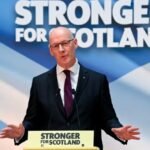A new report from the University of Edinburgh suggests that Scotland’s marine energy sector could inject over £8 billion into the economy by 2050 while supporting thousands of jobs across the UK. The findings emphasize Scotland’s potential to lead the global charge in tidal and wave energy development.
Billions in Economic Benefits and Thousands of Jobs
Scotland has long been at the forefront of renewable energy, and this study underscores its potential dominance in marine energy. The report, commissioned by Scottish Enterprise and Wave Energy Scotland, estimates that nearly 9GW of tidal stream and wave energy could be deployed in Scottish waters by 2050.
If combined with additional deployments of approximately 3.6GW elsewhere in the UK, Scotland’s marine energy sector could contribute over £8 billion ($9.9 billion) in economic benefits. Additionally, it could support around 15,000 UK jobs, with the potential for another 46,000 jobs worldwide.
One sentence stands alone.

The Global Market Opportunity
The report goes beyond domestic benefits, suggesting that Scotland could capture a significant share of the global marine energy market. With a projected worldwide deployment of up to 300GW, the global market could be worth £28 billion to Scotland, further solidifying its leadership in the sector.
Key takeaways from the report include:
- The potential for up to 62,000 jobs in Scottish companies, with 15,000 based in the UK.
- A need for continued investment in infrastructure and supply chains to maintain Scotland’s competitive edge.
- The importance of long-term support for technology development to accelerate deployment.
Calls for Government and Industry Support
Suzanne Sosna, Director of Energy Transition at Scottish Enterprise, emphasized the urgency of taking action: “These findings really drive home the need to take action now if we want to reap the potentially sizeable economic benefits of remaining a world leader in marine energy.”
The study outlines several critical areas that require investment and strategic focus:
- Market Support: Consistent, long-term backing for marine energy developers to encourage large-scale deployment.
- Technology Innovation Funding: Increased investment in research and development to improve efficiency and cost-effectiveness.
- Infrastructure Enhancements: Upgrades to ports and grid connections to support large-scale marine energy projects.
- Skills Development: Training programs to ensure a qualified workforce capable of driving the sector forward.
- Supply Chain Modernization: Strengthening domestic manufacturing and production capabilities to reduce reliance on foreign suppliers.
Scotland’s Path to Global Leadership
Scotland has the opportunity to establish itself as the epicenter of marine energy innovation. With its rich natural resources and a strong history of engineering expertise, the country is well-positioned to take advantage of the growing demand for clean, renewable energy.
The report highlights Scotland’s extensive experience in innovation support and enterprise development, which could play a crucial role in securing its leadership position. By fostering collaboration between government, industry, and academia, Scotland could pave the way for a marine energy revolution.
One more standalone sentence.
The Road Ahead
With the right investment and policy framework, Scotland could emerge as the world leader in tidal stream and wave energy development. The challenge now lies in translating these ambitious projections into tangible actions that will drive economic growth, job creation, and global competitiveness in the marine energy sector.


















